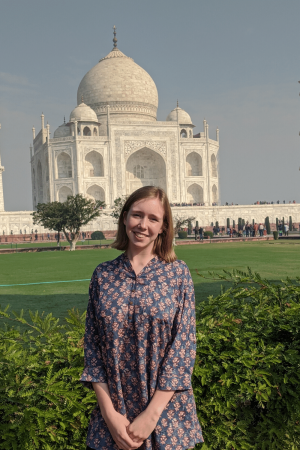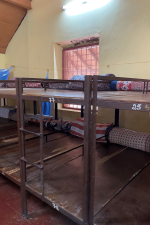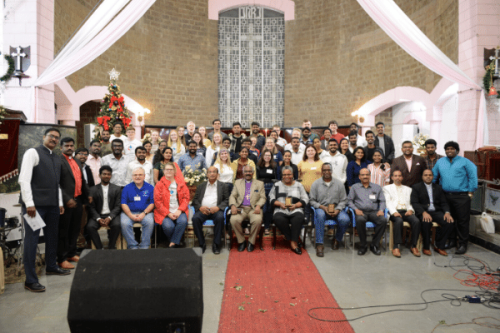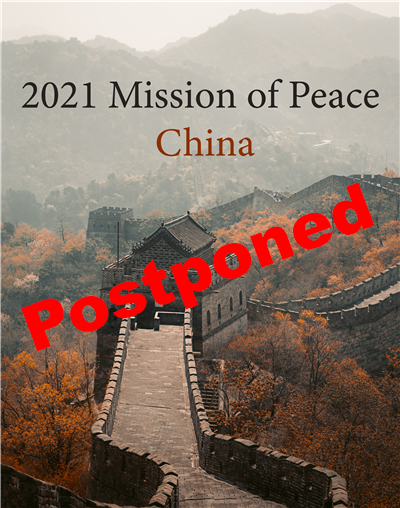Mission of Peace 2020: India

The BWC's 2020 Mission of Peace group: (Back row, L-R) Nito Slack, Bishop LaTrelle
Easterling, the Rev. Marion Easterling; (front row) Elizabeth Anderson and Maya Tzan.
Inspired by the preaching of the late Bishop Dale White, the Mission of Peace was brought into existence by the Northeastern Jurisdictional Council on Youth Ministry Legislative Session at Albright College, July 28-31, 1984. The Mission of Peace has traveled to Russia, China, Eastern Europe, Zimbabwe, Guyana, India, Nicaragua, Brazil, Cuba, and South Africa. In January 2020, a group of four people from the Baltimore-Washington Conference went to India. They included Bishop LaTrelle Easterling of the BWC, Elizabeth Anderson, Nito Slack, and Maya Tzan. The 2021 Mission of Peace is scheduled to go to China. Deadline to register/apply is March 1, 2020. Contact Cheryl Cook at
Elizabeth Anderson
Since I’ve returned from our Mission of Peace to India, I’ve been surprised by the number of details I remember. When I talk to people about the trip, I usually start off with broad aspects like places we went or messages we learned. And then I begin to recall small moments and feelings that may have lasted a few seconds or minutes of the trip at most.
 I remember reaching through the windows of a small church in the quiet reaches of Hyderabad to shake the hands of shy, giggling children outside during the passing of the peace. I remember the taste of warm gulab jamun and vanilla ice cream, and the way the flavor of the fried milk balls melted into the cream. I remember being speechless when I stood on the balcony of our hotel in Coorg and looked out at the restless trees and the rolling mountains full of vibrant life.
I remember reaching through the windows of a small church in the quiet reaches of Hyderabad to shake the hands of shy, giggling children outside during the passing of the peace. I remember the taste of warm gulab jamun and vanilla ice cream, and the way the flavor of the fried milk balls melted into the cream. I remember being speechless when I stood on the balcony of our hotel in Coorg and looked out at the restless trees and the rolling mountains full of vibrant life.
I remember feeling the presence of God wash over me within moments of entering the Bylakuppe Buddhist Golden Temple, first striking my heart and then enveloping my mind, soul, and body. I remember the expressions on the faces of children at the tiny native-language school we visited in Mangalore, and the joy of the teachers there despite not being paid nearly enough for their dedication.
I remember how sick I felt when I looked at the “holy” river behind the Taj Mahal, which appeared more like oil and waste than water. But on the other hand, I remember the sheer vastness and beauty of the Arabian Sea, the way the warm waves crashed at my feet and licked at my fingers when I bent down to touch them. I remember feeling absolutely honored to be invited to watch our Muslim guides perform their evening prayer.
It’s these small things that have reminded me more of the bigger picture of our trip than anything else. We weren’t in India to share our beliefs, customs, and ideas; we were there to listen, to absorb, and to learn from others. Our task now that we have returned is not to speak as though our eyes have already been opened and we suddenly know everything that India has to offer. Instead, it is to speak as our eyes are still being opened, and only to begin to open the eyes of others by the grace of God.
I understand more fully now the importance of seeing the world not from a Christian or American perspective but stepping into the shoes of others and taking in new perspectives no matter how different they are from my own. I also realize that words alone, on paper or in speech, cannot accomplish this.
To seek new views, we must step far out of our comfort zones and, for those who have the means, travel is an amazing opportunity for this. At home, it might mean interacting with new communities and discovering new ways to give and receive. Anything that can broaden our horizons even a little bit more is incredibly valuable.
Elizabeth Anderson is a senior at Linganore High School in Frederick. She attends Calvary UMC in Frederick. In her free time, she loves to read, write, play music, and dance. Elizabeth is a lover of world cultures and cuisine and hopes to study international relations in college.
Nito Slack
I waited for the day to come when I would leave home and embark on my second NEJ Mission of Peace (MOP), this time to India. I spent countless hours sitting up at night wondering, “How will God show his love through this trip?”
My fellow MOP participants and I were awestruck by India’s natural beauty and unity through diversity. It is impossible to pinpoint the moment I felt God on the trip because he was truly omnipresent, but I will try my best to capture the essence of some of the times I felt truly enveloped in the arms of the Holy Spirit.
Will a Buddhist man who orchestrates the feeding of 50,000 people every day not enter into the kingdom of God? Will a Muslim man who acts like Christ not enter into the kingdom of God? How can I tell a destitute orphan that because of her religion, she too will not enter into the kingdom of God?
These questions raced through my mind as we explored the awesome wonder of India. I was challenged at first with these notions but God, in his perfect timing, revealed the answer I had been looking for. If our friends in India are living Christ-like lives, they too shall enter into the heart of God.
 Standing in a room no bigger than many of our living rooms sat nearly three dozen wooden slats that were used as beds. All of them were filled by the orphans of the Church of South India. I began to cry. Feeling the presence of God in this place was nothing I have ever felt before. I reached out my hand and placed my hand on a bed and began to pray. I asked God to bless the child that slept there, asked God to pour out his love and grace upon her head and to never let her forget who’s she is. My hands slid from one splintered panel to another and then another and then another until I realized I was all alone.
Standing in a room no bigger than many of our living rooms sat nearly three dozen wooden slats that were used as beds. All of them were filled by the orphans of the Church of South India. I began to cry. Feeling the presence of God in this place was nothing I have ever felt before. I reached out my hand and placed my hand on a bed and began to pray. I asked God to bless the child that slept there, asked God to pour out his love and grace upon her head and to never let her forget who’s she is. My hands slid from one splintered panel to another and then another and then another until I realized I was all alone.
Just me and the Holy Spirit in an orphanage in southern India.
In Dharmastala, we witnessed the amazing provision of God through the feeding of nearly 50,000 people every day. From doctors to beggars they sat together and broke bread, as one. I saw God's awesome grace through those who spent their time serving, out of wheelbarrows, plate after plate of rice.
The NEJ Mission of Peace to India changed me forever. I saw God in ways I never had and met the Holy Spirit through other religions. “Dēvaru nanna śānti” A phrase that impacted me so much I now have it permanently tattooed on my body. A greeting of the people of India and a way of welcoming us home. "God is my peace."
Seeing the face of God in India was something I expected, but how it was revealed to me is something I will never forget. I saw the face of God in the eyes of orphans. I saw the face of God in the complete memorization of the Koran by a 13-year old. I saw the face of God In the lives being changed, both ours and the Indian people, by the radical hospitality and loving multiculturalism of India.
Nito Slack is a senior in the Academy of Visual And Performing Arts at Chopticon High School and attends Mt.Zion UMC in Mechanicsville.
Maya Tzan
As we boarded the bus after arriving in India, we were greeted with “Namaste.” Namaste is more than a simple “hello, nice meeting you,” a common greeting in our lives. It means, “I see the divinity in you.” Seeing the divinity in all of our neighbors was something India taught me to do.
India is home to a very diverse population. Christians are 2.5% of the Indian population, and 17% are Muslim, 80% are Hindu. In a country of so many differing views, huge strides are being made by the people of India to build interfaith relationships. While many of us may be used to seeing the divinity in only our religion, denomination, or church family, the people of India demonstrated how they saw the divinity in all other religions outside of their own.
One of the places we visited on the Mission of Peace was Dharmasthala, a Jain temple in Southern India. Jainism is an ancient Indian religion that has many similar aspects to Hinduism. Jainism is a religion of peace, respecting nature, and people. Dr. Veerendra Heggade, the leader of the Jains and the hereditary administrator of Dharmasthala, told us a story when we met with him.
Four blind men meet an elephant on a road. One man touches the elephant’s body and thinks it’s a wall. Another man touches the elephant's tail and thinks it’s a rope. Another touches the elephant’s ears and thinks that they are fans. One touches its legs and thinks they are tree trunks. None of them perceived the whole elephant. We are all like the blind men. In India, I had the opportunity to meet people different from me and exchange our experiences of the “elephant.”
One experience when I saw another side of the “elephant” was at the Henry Martyn Institute (HMI), a center for reconciliation and understanding between religions. There we heard Abdul Kareem, a very faithful Muslim man. When asked about his thoughts on Islamophobia, his response nearly brought me to tears. He said that extremists are not, in any way, following Islam. The idea of Islam being used in the name of hatred made him extremely upset. I was moved by his passion when it came to his religion. Islam is a religion of peace, he said.
As Christians, we cannot be the ones to propel a negative and completely false stereotype of Muslims due to an untrue picture painted by the media, hate groups, and society. When the world tells us to see differences with a negative lens, we should choose to see God in all of those that are different.
I encourage all of my brothers and sisters in Christ to learn about other religions. As another speaker at the HMI said, a way we can do this is to make “the conscious effort to un-learn and re-learn unconscious biases.” This means we should realize our inherently learned biases, and make moves to change them in ourselves, as a church, and as a world.
I hope that we, as The United Methodist Church, can come to appreciate all of God’s children and listen to their views of the world by simply by seeing the divinity in each other; by practicing “namaste.”
Maya Tzan is a sophomore at Century High School in Carroll County and attends Saint Paul's UMC in Sykesville.

Bishop LaTrelle Easterling
Blessed are the peacemakers, for they shall be called the children of God. (Matthew 5:9)
In his commentary on the book of Matthew, Douglas R. A. Hare states, “It is clear that peacemakers designates not those who live in peace, enjoying its fruits, but those who devote themselves to the hard work of reconciling hostile individuals, families, groups and nations.”
Peacemaking is hard work. Perhaps in its deepest sense, peacemaking is working toward the welfare of all people. For all to enjoy a measure of well-being, there must be mutual respect, care, and the recognition of the personhood of others. I know no other way of creating that kind of mutuality than through the cultivating of relationships. Relationships break down barriers and dispel stereotypes.
Whether we travel across the street or across the globe, building relationships can happen as we experience new persons and communities. I had the opportunity to do so when I traveled to India with the NEJ Mission of Peace in December. This pilgrimage of 16 young adults, including Elizabeth Anderson, Nito Slack, and Maya Tzan of the Baltimore-Washington Conference, was an immersion in diversity and the beauty of God’s creativity. From families opening their homes to us and sharing delicious Indian cuisine, to congregations holding special services to lay hands on us and pray, to local entrepreneurs giving us a glimpse of their businesses, we formed relationships that will provide opportunities for inter-faith ministry and friendship.
As we were given the privilege of entering the sacred spaces of our hosts, we encountered a holy presence that was both familiar and yet quite unique. Within the 800-year old Hindu Temple in Dharmasthala, we witnessed pilgrims who had traveled for days to pray, receive an anointing of oil and water, and ask for healing. Although we could not understand their words, we felt the depth of their prayers and related to the earnestness of their supplications.
We also witnessed the incredible feeding ministry that takes place within the Temple every day. Without regard to wealth, station or title, thousands of sojourners are fed in a large common space. They sit next to one another giving thanks and feasting together as one people.
We also felt a deep presence of holiness as we entered the Tibetan temple in Coorg. Sitting together on the floor in prayer, one of the pilgrims asked me if I could feel the heat. Upon further inquiry, I learned he was speaking of the heat emanating from the statues in the center of the Temple. This holy space, built in the 1960s as Tibetans were exiled and migrated to Coorg, is the site of deep prayer by Tibetan monks every day. As I looked into the eyes of the monks gathered for prayer, I saw the seriousness of committed disciples. The collective power of their prayers was generating a literal physical heat.
In our current climate of xenophobia and the rising suspicion of persons of other faiths, it was refreshing to visit The Henry Martyn Institute on the trip. This Institute, which is located Hyderabad, India, is dedicated to promoting reconciliation between people of different faiths and cultures. As we received a tour of the facility and heard engaging presentations, we encountered scholars of varied religious traditions, including Christianity, Islam, Buddhism, and Hinduism.
Being in their presence I was keenly aware of and compelled by their deep respect for one another’s beliefs and traditions. Each one was squarely rooted in their own faith, but their intellectual curiosity and desire for greater understanding created a safe space for dialogue and learning.
The director of the Institute, Rev. Packiam T. Samuel, invited us to return to the Institute for an intentional time of study and reflection. He said, “This is not the kind of work that can be done as tourists; you have to spend time getting to know one another and learning of each other’s faiths.”
In other words, Samuel was reiterating that reconciliation requires relationships. At the heart of each of these religions is a desire for peace and the fulfillment of human life. In the halls of the Institute I did not feel any fear of the other; rather, I felt immense hope at the possibility of real understanding and peace.
While serving as a district superintendent in the New England Conference, I was invited to serve as the keynote speaker for a Martin Luther King, Jr. celebration. In preparing for that address, the questions that kept percolating within me were, “Who do we invite into our homes? Who do our children see as guests at our tables?”
While we extol the virtues of Dr. King each year, are we moving beyond our cultural, racial and religious peer groups to build relationships across broader constituencies? Reflecting upon the words of Rev. Samuel, making King’s dream a reality will require more than commemorative tourism; it will require spending some time with one another. It will require creating safe spaces for conversation, learning, and the dismantling of years of learned bias.
The only lasting path to reconciliation and peace is through creating meaningful relationships with persons of other races, nationalities, beliefs and customs. May the words of Lao-Tzu, a Chinese philosopher, guide us. He teaches:
If there is to be peace in the world,
there must be peace in the nations.
If there is to be peace in the nations,
there must be peace in the cites.
If there is to be peace in the cities,
there must be peace between neighbors.
If there is to be peace between neighbors,
there must be peace in the homes.
If there is to be peace in the homes,
there must be peace in the heart.
As children of God, may we open our hearts, minds and homes to new friends. May we become peacemakers. Yes, it is hard work, but many hands make the burden easier.

Due to Covid-19 and guidelines for international travel,
the Mission of Peace to China has been postponed.
For additional information, contact Cheryl Cook.

What a wonderful experience! Thank you for sharing your insightful and inspiring messages. We must be open to learning about other cultures and religions and to appreciating their concept of God’s meaning for us.
I am in awe of what I have just read. So inspiring, so beautiful, I’m speechless. I wish everyone would take the time to read this. Thank you for sharing your experience and for making a true difference in this world. We have a long way to go but I thank God for Elizabeth, Nito, Maya and Bishop Easterling. I am so inspired to do more. God Bless